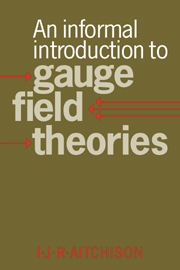Book contents
- Frontmatter
- Contents
- Preface
- Preface to the Paperback Edition
- 1 Introduction and motivations
- 2 Symmetries in quantum field theory: I Manifest
- 3 Gauge fields and the gauge principle
- 4 Quantisation of vector fields: I Massless
- 5 Quantisation of vector fields: II Massive
- 6 Symmetry in quantum field theory: II Hidden
- 7 Theory of weak and electromagnetic interactions
- 8 Renormalisation matters
- References
- Index
8 - Renormalisation matters
Published online by Cambridge University Press: 20 January 2010
- Frontmatter
- Contents
- Preface
- Preface to the Paperback Edition
- 1 Introduction and motivations
- 2 Symmetries in quantum field theory: I Manifest
- 3 Gauge fields and the gauge principle
- 4 Quantisation of vector fields: I Massless
- 5 Quantisation of vector fields: II Massive
- 6 Symmetry in quantum field theory: II Hidden
- 7 Theory of weak and electromagnetic interactions
- 8 Renormalisation matters
- References
- Index
Summary
Renormalisation is so central a topic in quantum field theory – and particularly in gauge field theories – that even an informal introduction to the latter should not omit all mention of it. Indeed, it has already been touched on several times in earlier chapters. In this final chapter, we want to review (while shamelessly borrowing technical details from reliable sources) several important aspects of renormalisation, especially those which impinge particularly on gauge theories.
A renormalisable theory is one in which, by introducing a finite number of parameters taken from experiment, calculations of physical quantities can be carried out, with finite results, up to (in principle) arbitrarily high orders in perturbation theory, by following a well-defined calculational procedure. The main ideas in the procedure will be illustrated for QED in Section 8.1. By contrast, no such procedure has, as yet, been devised for theories which are not renormalisable: in these terms, such theories would require the introduction of an infinite number of arbitrary constants. Of course, we could always fit data with such a theory, but it seems clear that we would have very few real predictions to make. In QED, on the other hand, many predictions can be made, to an accuracy of a few parts per million, given just the values of the fundamental charge e and the electron mass (and possibly masses of other particles); and these predictions have been verified experimentally. At present, then, and until such time as a procedure is invented for obtaining finite physical predictions from theories which are not renormalisable in perturbation theory, the only calculable theories are renormalisable ones. This is a good reason for restricting attention to such theories.
Information
- Type
- Chapter
- Information
- An Informal Introduction to Gauge Field Theories , pp. 125 - 163Publisher: Cambridge University PressPrint publication year: 1982
